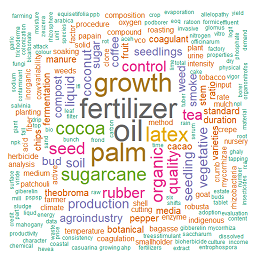Pengaruh Pupuk Hayati Berbasis Jamur Mikoriza Arbuskular dan Rhizobakteri Pemacu Pertumbuhan Tanaman terhadap Pertumbuhan Bibit Kakao (Theobroma cocoa L.)
DOI:
https://doi.org/10.25181/jaip.v8i1.1371Keywords:
bio fertilizer, cocoa seedlings, growthAbstract
One effort to improve quality of cocoa seedlings is application of bio fertilizer during the nursery. Nutrient supply is essential for growth and development of cocoa seedlings at nursery and field after transplanting. The aim of this research is to determine effect of bio fertilizer application to growth of cocoa seedlings. The study used a completetly randomized design with 4 treatments and 15 replications. The treatments were no fertilization (P1), chemical fertilization (P2), bio fertilizer every 2 weeks (P3) and bio fertilizer every 1 month (P4). The result showed that application of bio fertilizer every 2 weeks and 1 month can increase height, diameter and dry weight of cocoa seedlings on first until fourth months after fertilization. The Mycorrhizal Dependency (MD) of cocoa seedlings was classified as moderately dependent (27,04–45,86%). The highest colonization of arbuscular mycorrhizal fungi on roots cocoa resulted by P4 treatment about 33,92%.Downloads
References
Babbu, G. A., & Reddy, M. S. (2011). Diversity of arbuscular mycorrhizal fungi associated with plants growing in fly ash pond and their potential role in ecological restoration. Current Microbiol., 63, 273-280
Balai Penelitian Tanah. (2009). Analisis kimia tanah, tanaman, air dan pupuk. Balai Besar Litbang Sumber Daya Lahan Pertanian. Badan Penelitian dan Pengembangan Pertanian. Departemen Pertanian.
Cruz, R. E., de la Zarade, J. F., Agganzae, N. S., & Lorilla, E. B. (1999). Differential mycorrhizal development of some agricultural, horticultural and forestry crops to inoculation of mycorrhizal fungi. In: D Jasper (Ed.). Proceedings of the International Symposium on Management ofMycorrhizas on Agriculture, Horticulture and Forestry. Australian Institute of Agricultural Sciences, Australia.
Famuwagun, I. B., & Titilayo, O. (2016). Influence of varying rates of fertilizers on the performance of cacao (Theobroma cacao L.) seedlings in nursery. Int. Lett. Nat. Scie., 58, 54-59
Firmansyah, I., Syakir, M., & Lukman, L. (2017). Pengaruh kombinasi pupuk N, P dan K terhadap pertumbuhan dan hasil tanaman terung (Solanum melongena L.). J. Hort., 27(1), 69-78.
Gianinazzi, S., Gollotte, A., Binet, M. N., van Tuinen, D., Redecker, D., & Wipf, D. (2010). Agroecology: the key role of arbuscular mycorrhizal in ecosystem services. Mycorrhiza, 20, 519-530.
Laslo, E., Gyorgy, E., Mara, G., Tamas, E., Abraham, B., & Lanyi, S. (2010). Screening of plant growth promoting rhizobacteria as potential microbial inoculants. Crop Prot., 40, 43-48.
Nadeem, S. M., Ahmad, M., Zahir, Z. A., Javaid, A., & Ashraf, M. (2014). The role of mycorrhizae and plant growth promoting rhizobacteria (PGPR) in improving crop productivity under stressful environments. Biotechnol. Adv., 32(2), 429-448.
Nasaruddin. (2012). Respon pertumbuhan bibit kakao terhadap inokulasi Azotobacter dan mikoriza. J. Agrivigor., 11(2), 310-311
Otman, A., Jalil, A. M. M., Wang, K. K., Ismail, A., Ghani, N. A., & Adenan, I. (2010). Epicatechin content and antioxidant capacity of cocoa beans from four different countries. Afr. J. Biotechnol., 9(7), 1052-1059
Phillips, J. M., & Hayman, D. S. (1970). Improved procedures for clearing roots and staining parasitic and vesicular arbuskular mycorrhizal fungi for rapid assesment of infection. Transact Brit. Mycol. Soc, 55, 158-161
Plenchette, C., Fortin, J. A., & Furlan, V. (1983). Growth responses of several plant species to mycorrhizae in a soil of moderate P-fertility. I. Mycorrhizaal dependency under field conditions. Plant Soil, 70(2), 199-209.
Radhakrishnan, R., Hashem, A., & Abd_Allah, A. F. (2017). Bacillus: a biological tool for crop improvement through bio-molecular changes in adverse environments. Frontiers Physiol, 8, 1-14
Ramirez, J. G., Osorno, L., & Osorio, N. W. (2016). Presence of mycorrhizal fungi and fluorescent Pseudomonas sp. in the rhizosphere of cacao in two agroecosystems and their effects on cacao seedling growth. Agron. Colomb, 34(3), 385-392
Rubiyo & Siswanto. (2012). Peningkatan produksi dan pengembangan kakao (Theobroma cacao L.) di Indonesia. Bull. RISTRI, 3(1), 33-48
Ruiz-Lozano, J. M., Porcel, R., Azcon, C., & Aroca, R. (2012). Regulation by arbuscular mycorrhizae of the integrated physiological response to sainity in plants: new challenges in physiological and molecular studies. J. Exp. Botany, 63(11), 4033-4044
Suparno, A., Prabawardani, S., Yahya, S., & Taroreh, N. A. (2015). Inoculation of arbuscular mycorrhizal fungi increase the growth of cocoa and coffee seedling applied with ayamaru phosphate rock. J. Agri. Scie, 7(5), 199-210.
Tawaraya, S. (2003). Arbuscular mycorrhizal dependency of different plant spesies dan cultivars. Soil Scie. Plant Nutr., 49(5), 655-668.
Wahyudi, T., Pangabean, T. R., & Pujiyanto. (2013). Panduan lengkap kakao: Manajemen agribisnis dari hulu hingga hilir. Penebar Swadaya. Jakarta.
Widnyana, I. K., & Javandira, C. (2016). Activities Pseudomonas sp. and Bacillus sp. to stimulate germination and seedling growth of tomato plants. Agri. Agric. Scie. Proc, 9, 419-423.
Downloads
Published
How to Cite
Issue
Section
License
Authors who publish with Jurnal Agro Industri Perkebunan agree to the following terms:
Authors retain copyright and grant the Jurnal Agro Industri Perkebunan right of first publication with the work simultaneously licensed under a Creative Commons Attribution License (CC BY-SA 4.0) that allows others to share (copy and redistribute the material in any medium or format) and adapt (remix, transform, and build upon the material for any purpose, even commercially) with an acknowledgment of the work's authorship and initial publication in Jurnal Agro Industri Perkebunan.
Authors are able to enter into separate, additional contractual arrangements for the non-exclusive distribution of the journal's published version of the work (e.g., post it to an institutional repository or publish it in a book), with an acknowledgment of its initial publication in Jurnal Agro Industri Perkebunan. Authors are permitted and encouraged to post their work online (e.g., in institutional repositories or on their website) prior to and during the submission process, as it can lead to productive exchanges, as well as earlier and greater citation of published work.


























